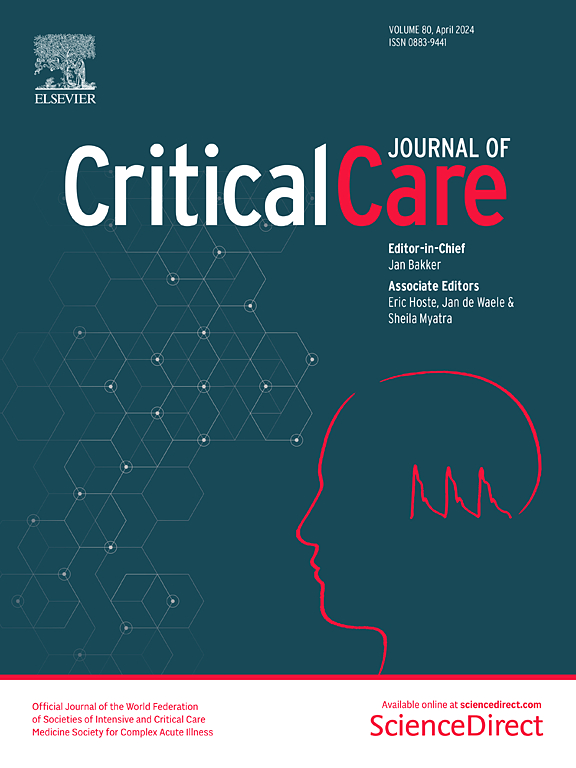Structural and functional alteration of the gut microbiomes in ICU staff: a cross-sectional analysis
IF 8.8
1区 医学
Q1 CRITICAL CARE MEDICINE
引用次数: 0
Abstract
16S rRNA sequencing has revealed structural alterations in the gut microbiomes of medical workers, particularly those working in intensive care unit (ICU). This study aims to further compare the taxonomic and functional characteristics of gut microbiomes between ICU staff and non-medical individuals using metagenomic sequencing. A prospective cross-sectional cohort study was conducted, fecal samples from 39 individuals in each group—ICU staff and non-medical subjects were analyzed using metagenomic sequencing. PERMANOVA (using the adonis function) was employed to analyze the genus-level profiles and assess the impact of individual parameters on the gut microbiome. Multiple databases were utilized to annotate and compare the functional differences in gut microbiomes between the two groups. We observed that ICU staff exhibited a significant decrease in gut microbiome diversity, characterized by a marked decline in Actinobacteria and a substantial increase in Bacteroides and Bacteroidaceae. CAZy annotation revealed a notable increase in carbohydrate-active enzymes within the ICU staff cohort. Kyoto Encyclopedia of Genes and Genomes (KEGG) analysis further indicated an elevated risk of endocrine and metabolic disorders, along with enhanced glycan biosynthesis and metabolism. Additionally, KEGG pathway enrichment analysis highlighted significant enrichment in cancer-related pathways. Analysis using the Virulence Factor Database (VFDB) showed a higher abundance of virulence factors associated with immune modulation, invasion, and antimicrobial activity/competitive advantage among ICU staff. Notably, no discernible difference in the presence of antibiotic resistance genes within the gut microbiomes was observed between the two groups. Importantly, all aforementioned differences demonstrated clear gender disparities. Our findings indicated that ICU staff exhibited a reduction in gut microbiome diversity which was associated with an increase in virulence factors and carbohydrate-active enzymes, as well as with a heightened susceptibility to endocrine and metabolic diseases and cancers.ICU工作人员肠道微生物群的结构和功能改变:一项横断面分析
16S rRNA测序揭示了医务工作者,特别是在重症监护病房(ICU)工作的人员肠道微生物组的结构变化。本研究旨在利用宏基因组测序技术进一步比较ICU工作人员与非医疗个体肠道微生物组的分类和功能特征。采用前瞻性横断面队列研究,对每组39例icu工作人员和非医学受试者的粪便样本进行宏基因组测序分析。使用PERMANOVA(使用adonis函数)分析属水平概况并评估个体参数对肠道微生物组的影响。使用多个数据库来注释和比较两组之间肠道微生物组的功能差异。我们观察到ICU工作人员肠道微生物群多样性明显下降,其特征是放线菌群明显下降,拟杆菌和拟杆菌科显著增加。CAZy注释显示,在ICU工作人员队列中,碳水化合物活性酶显著增加。京都基因与基因组百科全书(KEGG)分析进一步表明,内分泌和代谢紊乱的风险增加,同时糖的生物合成和代谢增强。此外,KEGG通路富集分析强调了癌症相关通路的显著富集。使用毒力因子数据库(VFDB)分析显示,在ICU工作人员中,毒力因子的丰度较高,与免疫调节、侵袭和抗菌活性/竞争优势相关。值得注意的是,在肠道微生物组中没有观察到两组之间存在的抗生素抗性基因的明显差异。重要的是,上述所有差异都显示出明显的性别差异。我们的研究结果表明,ICU工作人员表现出肠道微生物群多样性的减少,这与毒力因子和碳水化合物活性酶的增加有关,并且与内分泌和代谢疾病和癌症的易感性增加有关。
本文章由计算机程序翻译,如有差异,请以英文原文为准。
求助全文
约1分钟内获得全文
求助全文
来源期刊

Critical Care
医学-危重病医学
CiteScore
20.60
自引率
3.30%
发文量
348
审稿时长
1.5 months
期刊介绍:
Critical Care is an esteemed international medical journal that undergoes a rigorous peer-review process to maintain its high quality standards. Its primary objective is to enhance the healthcare services offered to critically ill patients. To achieve this, the journal focuses on gathering, exchanging, disseminating, and endorsing evidence-based information that is highly relevant to intensivists. By doing so, Critical Care seeks to provide a thorough and inclusive examination of the intensive care field.
 求助内容:
求助内容: 应助结果提醒方式:
应助结果提醒方式:


